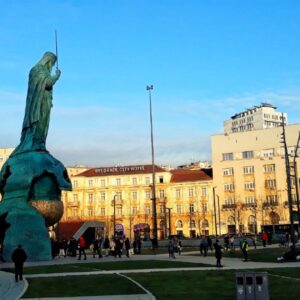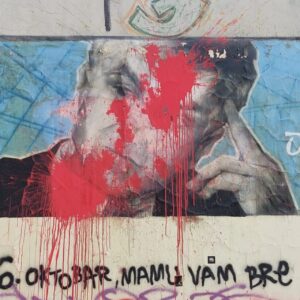#SmutsMustFall: The Forgotten Battle to Counter the Legacy of one of Apartheid’s Most Prominent Architects
By Cameron Scheijde •
‘Churchill was a racist,’ read the hastily-daubed paint on the bottom of Parliament Square’s towering effigy to one of Britain’s most revered wartime icons, sparking fierce debate and controversy over how the UK views its complex and difficult past. Churchill’s statue, having been viewed for 50 years by most as a symbol of heroism rather than shame, now reflects the strongly ingrained divisions and contentions that run deep into the fabric of British society.
Hidden for a time behind a coffin-like cocoon, joined by six Metropolitan Police officers, and now behind the same barriers that stand between the public masses and parliament’s gilded gates, Churchill’s decades of near-unanimous admiration through the rose-tinted glasses of British imperial amnesia seem to be at an end. The barriers themselves stand as a contextual plaque of sorts, marking him out as a controversial figure, a target, and as such joining the ranks of colonial generals and imperial relics behind the blockades of government protection all around the world. Quite the opposite of ‘erasing’ history, the actions of a protestor with a spray can do more to reveal the truth of Churchill’s unsavoury legacies than any history curriculum has managed since 1945.
Yet while the unique position that Churchill occupies in British national myth-building explains the emotion and attention that his statue provokes, it seems to be a more damning indictment of British historical education that the statue situated a few steps down from Churchill’s has enjoyed as little scrutiny as those of Mandela or Fawcett.
The statue in question is that of former South African Prime Minister Jan Christiaan Smuts – whose bronze likeness towers in similar reverence to any of the other prominent men standing around London’s symbolic democratic heart, upon a marble plinth, dressed in military regalia, stepping forward in a show of strength and holding an almost cartoon-like expression. The initial proposal for the statue, and the driving force behind its erection, came from Winston Churchill himself.
Smuts has thus held his position, almost unquestioned, for 65 years. When unveiled, he became only the second foreign leader to have a statue in Parliament Square – after Abraham Lincoln. He stands surrounded by Prime Ministers, from Churchill to Lloyd George to Palmerston, and looks over a square facing a statue of Nelson Mandela – who was imprisoned by and dedicated his life to dismantling, the system and state that Smuts was responsible for building. In Parliament Square, we see not only Britain’s confusion and struggle with its complex past, but also in physical space the battles for justice that occurred 6,000 miles away.1
Despite this distance, however, the history of South Africa and Britain are interlinked – for they have been forced that way by centuries of colonial interference and military alliances. As a result, scrutiny of Churchill’s statue naturally complements a call for questions over Smuts’ position too. After all, Smuts occupies his proud position solely by virtue of his alliance with Churchill’s government during the Second World War. The problem, however, is in one of Britain’s most fundamental shortcomings: a lack of space for engagement with the legacies of colonialism, conquest and slavery that not only built the country’s place in the world but still defines its relation with it. After all, someone wandering through Westminster may recognise Churchill, Cromwell or Gandhi, but would be forgiven for passing Smuts off as one of the hundreds of other statues to various British military generals in London.
You will not understand how modern Britain came to be, how it defines its relationship with the world and responds to complex historical dilemmas by learning about the six wives of Henry VIII. The imprisonment of Mary Queen of Scots or Elizabeth I’s alleged virginity will not further your comprehension of the Britain that exists today. Whilst all important aspects of any historical undertaking, the complete neglect of what is a very recent colonial past speaks volumes about how Smuts’ legacy has for so long been hidden in plain sight.
Smuts was, like Rhodes before him, responsible for much of what formed apartheid, South Africa. His racist and violent policies forced Black South Africans – many of whom were forced to fight and die with little recognition in the War that earned his prestigious statue – out of citizenship and stripped them of their humanity. The effects of his policies are still felt in South Africa today. He wrote of African people as ‘child-like… with a child psychology and outlook’, and spoke of equality as of ‘little good to the African2’. Reflecting with admiration on the ‘native’ policies of fellow imperialist Cecil Rhodes, Smuts used the guise of ‘self government’ to further the aim of stripping indigenous South Africans of their land and forcing them into deprived ‘homelands’ that stood until 1994.
For Smuts, the goal of a united South Africa under white supremacy dominated his thoughts on race, and he viewed South Africa as belonging to white rule and under European influence, determined to prevent it from falling into the ‘black pool of Africa’. This language evokes direct comparisons with apartheid’s first Prime Minister and Afrikaner nationalist D. F. Malan in 1948 when apartheid was implemented as policy, who spoke of needing to prevent European ‘development’ from vanishing ‘without honour in the black sea of South Africa’s non-European population.’3
Despite these policies occurring so far from Parliament Square, Smuts remained an undeniably important figure for British history as well. He was educated at Cambridge and, after a war that had truly destroyed the relationship between South Africa’s British and Afrikaner settlers, sought a reconciliatory tone that would unite British and Afrikaner rule. Yet despite the bonds that tie Africa and the UK together, the stories of the villains, and indeed heroes, of African history remain untouched by British historical education, as if colonialism was something only ever suffered, and never perpetrated.
South Africa knows of Smuts’ legacy, for the effects of his viciously racist policies are still being felt. Yet questions remain about how the preservation of Smuts’ public image continues to impact Britain’s self-image and myth-building over the Empire’s shame. To date, the only effort to counter his legacy was in his old Cambridge college, where students sought the removal of his prominent portrait in the Great Hall. The portrait remains,4 and little more attention has been paid to it.
Churchill’s statue will always attract more attention, as he occupies such a firm and immovable position in British national identity. His contested legacy will always evoke strong reactions. Smuts does not command such reverence from the British public, few know of him at all, yet his continued presence in Parliament Square, at a time when little public commemoration of him remains in South Africa, sends a message that Britain’s reckoning with colonialism has far further to go.
Harbouring statues of Smuts in positions as prestigious and synonymous with grandeur as Parliament Square, outside one of the oldest democratic assemblies in the world, sends the message that the UK need not work to redress the injustices of the past. Instead, those lurking on the fringe of colonial memory are, at best, forgotten, and at worst, admired.
With a global reckoning for justice and equality only gaining momentum, previously unnoticed shadows of the past may need to be revisited.
1. Sergen Bahceci, ‘Parliament Square and the Cultural Balance of Power in Britain’, Researching Sociology, (21 June 2016). Website.
2. Jan Smuts, ‘Native Policy in Africa’, Journal of the Royal African Society, 29: 115, 248-268.
3. Shula Marks, ‘White Masculinity: Jan Smuts, Race and the South African War’, Proceedings of the British Academy, 111, 12.
4. Christ’s College, Cambridge, ‘Smuts Portrait in Hall’, Christ’s College (13 August 2018). Website. https://www.christs.cam.ac.uk/news/smuts-portrait-hall.




